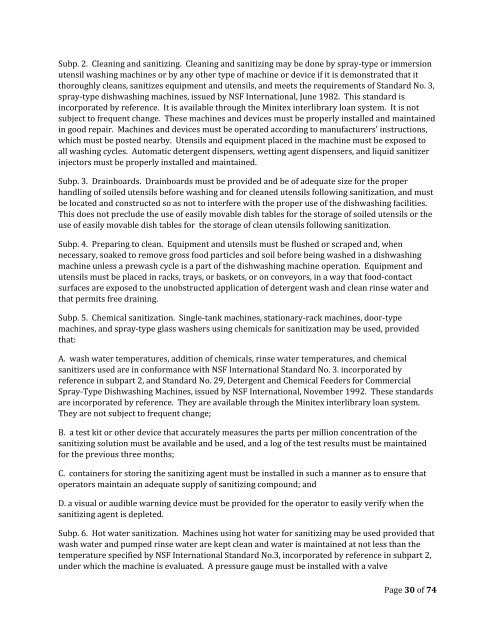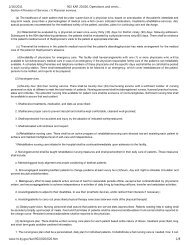State Regulations Pertaining to Dietary Sanitation & Environmental ...
State Regulations Pertaining to Dietary Sanitation & Environmental ...
State Regulations Pertaining to Dietary Sanitation & Environmental ...
You also want an ePaper? Increase the reach of your titles
YUMPU automatically turns print PDFs into web optimized ePapers that Google loves.
Subp. 2. Cleaning and sanitizing. Cleaning and sanitizing may be done by spray-type or immersion<br />
utensil washing machines or by any other type of machine or device if it is demonstrated that it<br />
thoroughly cleans, sanitizes equipment and utensils, and meets the requirements of Standard No. 3,<br />
spray-type dishwashing machines, issued by NSF International, June 1982. This standard is<br />
incorporated by reference. It is available through the Minitex interlibrary loan system. It is not<br />
subject <strong>to</strong> frequent change. These machines and devices must be properly installed and maintained<br />
in good repair. Machines and devices must be operated according <strong>to</strong> manufacturers' instructions,<br />
which must be posted nearby. Utensils and equipment placed in the machine must be exposed <strong>to</strong><br />
all washing cycles. Au<strong>to</strong>matic detergent dispensers, wetting agent dispensers, and liquid sanitizer<br />
injec<strong>to</strong>rs must be properly installed and maintained.<br />
Subp. 3. Drainboards. Drainboards must be provided and be of adequate size for the proper<br />
handling of soiled utensils before washing and for cleaned utensils following sanitization, and must<br />
be located and constructed so as not <strong>to</strong> interfere with the proper use of the dishwashing facilities.<br />
This does not preclude the use of easily movable dish tables for the s<strong>to</strong>rage of soiled utensils or the<br />
use of easily movable dish tables for the s<strong>to</strong>rage of clean utensils following sanitization.<br />
Subp. 4. Preparing <strong>to</strong> clean. Equipment and utensils must be flushed or scraped and, when<br />
necessary, soaked <strong>to</strong> remove gross food particles and soil before being washed in a dishwashing<br />
machine unless a prewash cycle is a part of the dishwashing machine operation. Equipment and<br />
utensils must be placed in racks, trays, or baskets, or on conveyors, in a way that food-contact<br />
surfaces are exposed <strong>to</strong> the unobstructed application of detergent wash and clean rinse water and<br />
that permits free draining.<br />
Subp. 5. Chemical sanitization. Single-tank machines, stationary-rack machines, door-type<br />
machines, and spray-type glass washers using chemicals for sanitization may be used, provided<br />
that:<br />
A. wash water temperatures, addition of chemicals, rinse water temperatures, and chemical<br />
sanitizers used are in conformance with NSF International Standard No. 3. incorporated by<br />
reference in subpart 2, and Standard No. 29, Detergent and Chemical Feeders for Commercial<br />
Spray-Type Dishwashing Machines, issued by NSF International, November 1992. These standards<br />
are incorporated by reference. They are available through the Minitex interlibrary loan system.<br />
They are not subject <strong>to</strong> frequent change;<br />
B. a test kit or other device that accurately measures the parts per million concentration of the<br />
sanitizing solution must be available and be used, and a log of the test results must be maintained<br />
for the previous three months;<br />
C. containers for s<strong>to</strong>ring the sanitizing agent must be installed in such a manner as <strong>to</strong> ensure that<br />
opera<strong>to</strong>rs maintain an adequate supply of sanitizing compound; and<br />
D. a visual or audible warning device must be provided for the opera<strong>to</strong>r <strong>to</strong> easily verify when the<br />
sanitizing agent is depleted.<br />
Subp. 6. Hot water sanitization. Machines using hot water for sanitizing may be used provided that<br />
wash water and pumped rinse water are kept clean and water is maintained at not less than the<br />
temperature specified by NSF International Standard No.3, incorporated by reference in subpart 2,<br />
under which the machine is evaluated. A pressure gauge must be installed with a valve<br />
Page 30 of 74



